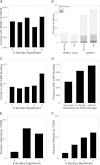Cross-species transcriptomic analysis elucidates constitutive aryl hydrocarbon receptor activity
- PMID: 25467400
- PMCID: PMC4301818
- DOI: 10.1186/1471-2164-15-1053
Cross-species transcriptomic analysis elucidates constitutive aryl hydrocarbon receptor activity
Abstract
Background: Research on the aryl hydrocarbon receptor (AHR) has largely focused on variations in toxic outcomes resulting from its activation by halogenated aromatic hydrocarbons. But the AHR also plays key roles in regulating pathways critical for development, and after decades of research the mechanisms underlying physiological regulation by the AHR remain poorly characterized. Previous studies identified several core genes that respond to xenobiotic AHR ligands across a broad range of species and tissues. However, only limited inferences have been made regarding its role in regulating constitutive gene activity, i.e. in the absence of exogenous ligands. To address this, we profiled transcriptomic variations between AHR-active and AHR-less-active animals in the absence of an exogenous agonist across five tissues, three of which came from rats (hypothalamus, white adipose and liver) and two of which came from mice (kidney and liver). Because AHR status alone has been shown sufficient to alter transcriptomic responses, we reason that by contrasting profiles amongst AHR-variant animals, we may elucidate effects of the AHR on constitutive mRNA abundances.
Results: We found significantly more overlap in constitutive mRNA abundances amongst tissues within the same species than from tissues between species and identified 13 genes (Agt, Car3, Creg1, Ctsc, E2f6, Enpp1, Gatm, Gstm4, Kcnj8, Me1, Pdk1, Slc35a3, and Sqrdl) that are affected by AHR-status in four of five tissues. One gene, Creg1, was significantly up-regulated in all AHR-less-active animals. We also find greater overlap between tissues at the pathway level than at the gene level, suggesting coherency to the AHR signalling response within these processes. Analysis of regulatory motifs suggests that the AHR mostly mediates transcriptional regulation via direct binding to response elements.
Conclusions: These findings, though preliminary, present a platform for further evaluating the role of the AHR in regulation of constitutive mRNA levels and physiologic function.
Figures





References
-
- Bunger MK, Glover E, Moran SM, Walisser JA, Lahvis GP, Hsu EL, Bradfield CA. Abnormal liver development and resistance to 2,3,7,8-tetrachlorodibenzo-p-dioxin toxicity in mice carrying a mutation in the DNA-binding domain of the aryl hydrocarbon receptor. Toxicol Sci Off J Soc Toxicol. 2008;106:83–92. doi: 10.1093/toxsci/kfn149. - DOI - PMC - PubMed
Publication types
MeSH terms
Substances
Grants and funding
LinkOut - more resources
Full Text Sources
Other Literature Sources
Miscellaneous

